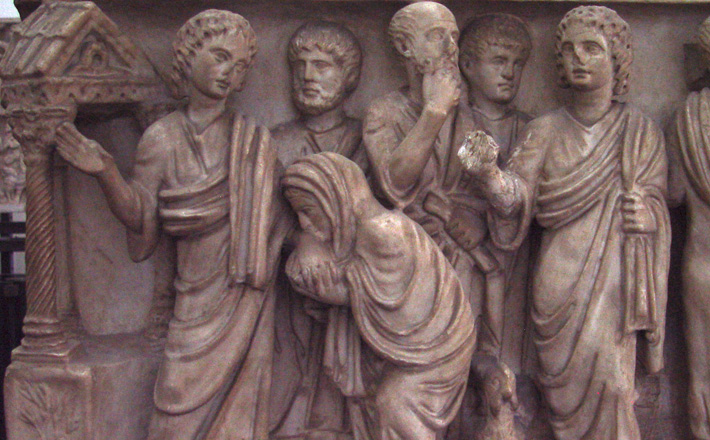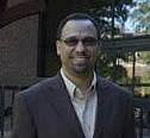Commentary on Luke 13:10-17
In Luke’s narrative, two scenes of Jesus’ teaching sandwiches this account of healing and controversy with religious leaders.
Jesus teaches that “suffering” doesn’t imply “sinfulness” (13:1-5) before telling a parable about mercy (cf. 13:6-7). On the other end of the synagogue healing is another parable, about how God’s kingdom grows (i.e., mustard seed and yeast) to manageable, and not unusually large, sizes. By the end of the chapter, Jesus laments over Jerusalem (cf. 13:34-35).
Commentary
Jesus enters synagogues frequently (cf. 4:15, 16; 6:6-11); this time, he seems to be in search of something. Just before this scene, Luke records a parable in which Jesus’ vineyard owner says, “For three years I have come looking for fruit on this fig tree, and still I find none” (Luke 13:7). His sensitivity is heightened as he continues to search for “fig trees” that are bearing fruit. He enters the synagogue immediately following this parable.
Jesus’ recent apocalyptic visions (cf. 12:49-56) do not hinder him from continuing to do earthly good. On this occasion, he finds and releases a “daughter of Abraham” (cf. 13:10-13). Earlier, he healed a man whose hand had withered (cf. 6:6-11). Now, Jesus heals a female who had a crippling back deformity.
On both occasions, Luke describes Jesus teaching in a synagogue on the Sabbath, but we are not informed about the content of his teaching. On both occasions, prominent religious leaders take offense at Jesus’ actions because of their view of what is allowable on the holy Sabbath day. By the end of chapter 13, Jesus’ search will turn into lament, “O Jerusalem, Jerusalem…” (cf. 13:34-35).
In neither story is Luke’s focus on the specific content of Jesus’ teaching. Rather, Jesus notices a man or woman in need and allows them to interrupt his teaching. In neither case is there any mention of “faith” on behalf of the recipient; Jesus initiates the action. And, Jesus expresses his power over “spirit” forces (in chapter 13) and “natural” forces (chapter 6) as well. Both stories are healing stories but, more significantly, for Luke, is the controversy these healings create due to questions of Jesus’ Sabbath practices. In both accounts, Jesus seems aware of this tension and provides explanations, albeit minimal ones (cf. 6:9; 13:15-16).
The ending of chapter 13 is significantly different from the earlier story. In Luke 6, the religious leaders depart from the synagogue trying to think of what to do with Jesus; and, they were furious (6:11). Their negative response will have major consequences later in the narrative. In Luke 13, the synagogue crowd rejoices at Jesus’ healing action (and teaching?). And, here, his “opponents” are disgraced.
In an honor/shame society, like first-century Palestine, this public shaming of the local synagogue leader is not good … for him or for his ability to lead this religious and social community in this small village. [Jesus had a more positive relationship with another synagogue leader earlier in the story (cf. 8:40-56).] This, too, has the potential to create problems for Jesus later in his mission.
But, the crowd is pleased and Luke highlights their reaction, a reaction that would be indicative of the divide over Sabbath practices in general in first century Judaism. Everyone was not on the same page. Compared to the earlier account, Jesus is beginning to receive a much more favorable reaction from the crowd (13:11).
According to Luke, Jesus’ opponents are not only human. Jesus describes his successful exorcizing activity as a sign of Satan’s decline (cf. 10:17-19; 11:18) and envisions the waning of Satan’s power because of it (cf. 10:18). The healing of this “daughter of Abraham” is, apparently, part of that activity (cf. 13:16). When referring to illnesses, Luke usually describes the breakdown of the body as due to, as in our story, a “weak spirit” (13:11, 12; the NRSV translates the Greek as “spirit” and “ailment”) and reserves the language of “unclean spirit” (cf. 4:36; 6:18; 8:29; 9:42) or “evil spirit” (cf. 7:21; 8:2) for people who need exorcisms. Nonetheless, in Luke’s world, some illnesses are also connected to “spirits.” [Apparently, this is not the case in Luke 6.] So, it is no surprise when Luke describes Judas’ ultimate act of deception as an activity enhanced by Satan’s entrance into his being (cf. 22:3).
So what?
This is not a theological debate about the origins of illness and physical deformities. Sometimes, in Luke’s narrative, these are due to the hand of “Satan” (cf. 13:16) and other times it is due to natural causes. Luke’s stories allow for both theological positions to find support in these accounts. There seems to be no general rule.
But this story is not told in order to discuss that theological issue. Rather this is a story about the role and function of our religious traditions, our claims about what could and should be practiced on the “Sabbath” or who is allowed within the walls of our synagogues and religious communities. Special religious practices may become hindrances to inclusion. We must be diligent to recognize what theological ideas we hold dear that disallow full participation from others.
And, Luke’s Jesus could not be clearer or more consistent on this point. He’s no Sabbath breaker! He operates well within Jewish tradition of the day. But he is also not one to allow the tradition to exclude people from access to the community and the potential for their healing. Many in the crowd agree.
These are stories about community. What kind of community do we want to be? And, do religious traditions help us to become that kind of community or do they hinder our desires? Will our traditions hinder the “daughter of Abraham,” in our day, from joining us today?


August 25, 2013